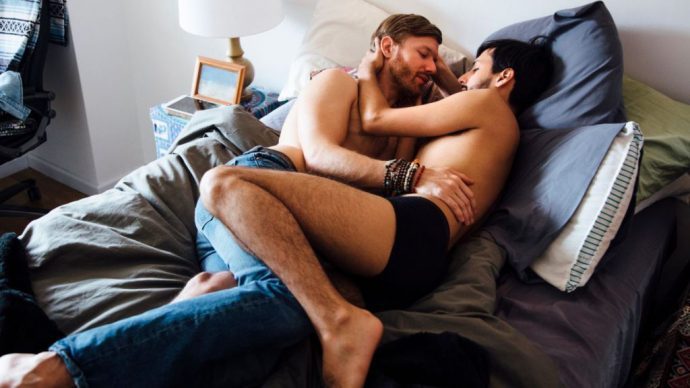
No, I don’t want to have sex with you
Let’s get one thing straight. So to speak.
We all know plenty of intelligent, informed heteros who would never fall for what you’re about to read.
But then again, we all know many who would.
The following myths are all based on questions or statements we’ve literally heard out of the mouths of ignorant straight people. If we’ve forgotten any, let us know in the comments!
1 That we all fancy them
Casual homophobia much?! Yes, for some, converting a straight person is the holy grail of gay sex.
But when we’re all lumped in that category, I get offended. It’s pre-judging someone (read: prejudice), plain and simple.
I remember a straight male friend once getting so uncomfortable when gay sex came on the TV, he had to leave the room. I think he thought the sight of it would turn me on to him. I didn’t have the heart to say he was about as appealing to me as genital herpes.
I’m all for experimentation, but I’m rarely attracted to straight people. I’m more into people who know what they want. As such, I find the idea of straight guys going ‘gay for pay’ in porn a turn off.
Also, I imagine sex with a straight person could get pretty complicated, and I’ve had enough clumsy and disastrous sex with gay people for one lifetime, thank you.

2 That all gay men like anal sex
This myth is so prevalent, even a lot of gay men believe it. But the truth is, for various reasons many of us don’t like giving or receiving anal sex, and prefer to stick to non-bum related activities.
It’s called ‘siding‘; a word we doubt many straight people are familiar with. Luckily, there’s no shortage of fun to be had outside of that area!
3 That lesbian sex is like porn
Now, I’m a gay man, so I can’t say this for sure. But I’m pretty certain that when two girls get together, it’s not like the movies.
And by movies, I of course mean hardcore pornography.
I’m openminded, but even I’m shocked by the unrealistic representation of lesbian sex in porn. And society generally, for that matter. For example, I doubt gay women always wear a full face of make up when they have sex – but what do I know.
Most depictions are clearly intended for the male gaze. This leads to the subliminal belief that lesbianism is ‘for them’, for their entertainment. This, of course, is gross.
4 That bisexuality isn’t real
So many people think bisexuality is just a stop on the way to Gaytown. But Evan Rachel Wood would beg to differ. The late David Bowie would beg to differ. And we beg to differ too. Plus, there’s the attitude that because some is bisexual, they want to sleep with everybody. Seriously?
5 That LGBTI people have sex constantly
Speaking of outdated stereotypes, this one bothers me the most.
By our very nature, queer people are openminded and adventurous when it comes to sex. Compared to our straight counterparts, anyway – we had to pluck up the courage to digress from the status quo, after all. So in a way, it’s cool to be seen as free and adventurous.
And sure, the promiscuity tag is not always unfounded, not that promiscuity is a bad thing. Many of us enjoy as much sex as possible, with as many partners as possible. To those people I say: good for you.
But to think that we have a one-size-fits-all approach to sexuality is crazy. And I hate it when people make assumptions about me, and my sex life, because I’m gay. You don’t know me!
6 That we don’t enjoy having sex with just one person
A continuation of number five. LGBTI people may be trailblazers when it comes to open and polyamorous relationships, but just as many of us enjoy sex with a single partner within the template of a conventional relationship.
Some people call this ‘heteronormative’. But I believe monogamy should be an option available to everyone, not just straight people.

7 That being top or bottom is a reflection of your personality
How many times has a straight person said to you ‘you’re clearly the top’ or ‘I’m guessing you’re the bottom’?
And they always say it in a smug, self-satisfied way – like they have some unique insight into your soul; a sixth sense, like they’re super clever for even knowing what ‘top’ and ‘bottom’ mean.
It’s even more enraging when they get it absolutely spot on.
But to believe my personality has any bearing on my sexuality, and vice versa, is such an amazingly basic assumption, I don’t even know where to begin. It obviously has nothing to do with manliness, or lack thereof.
How about dominant bottoms? How about passive tops? How about I’m everything? How about it doesn’t matter? How about it’s none of your damn business?
8 That, in fact, labels mean anything at all
Don’t get me wrong: I believe in labels. I think they’re essential for having intelligent conversations about the infinitely broad and complicated subject of sex and sexuality that actually make sense.
But I always take them with a pinch of salt – especially in an age of amazing sexual and gender fluidity.
I’m also a believer in the Kinsey scale. For example, just because I’m a gay man, it doesn’t mean I’m repulsed by the idea of sex with a woman, or that I’d rule it out in the future. Far from it.
For me, there isn’t a word out there that truly describes my sexuality, so I settle with gay, because it’s the most accurate. And my inkling is that’s the same for a lot of us.
9 That HIV and AIDs are ‘gay diseases’
Actually, this one annoys me the most. And it’s surprisingly common.
I’ve discussed with at least three friends their aversion to condoms, and always, their first concern is pregnancy. Then other STIs, and then, in the far, far distance, HIV and AIDs.
It makes me want to bang my head against a brick wall. Yes, sadly, HIV and AIDs disproportionately affects men who have sex with men – largely because the rate of transmission is 18 times higher through anal sex than vaginal.
But to think it’s only really an issue for gay men is outrageous – not to mention dangerous. Straight people can catch it, and do, every day, through sex and other means. So do lesbians. So do children. It is not a disease that discriminates.
According to aids.gov, for example, ‘an estimated 2.1 million individuals worldwide became newly infected with HIV in 2015, including 150,000 children under 15 years old, most of whom live in sub-Saharan Africa, and were infected by their HIV-positive mothers during pregnancy, childbirth or breastfeeding.’
For more myth busting around HIV and AIDs, read this feature.







